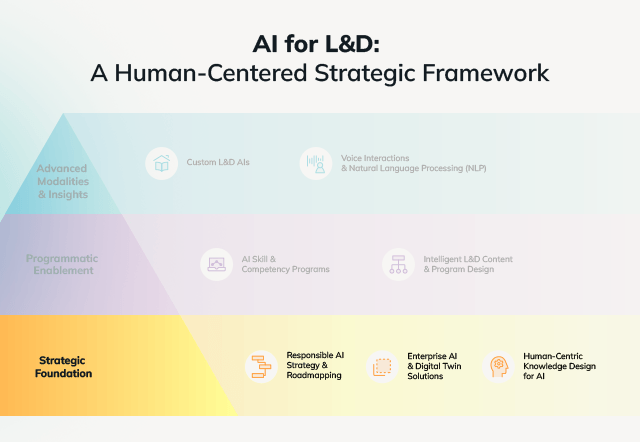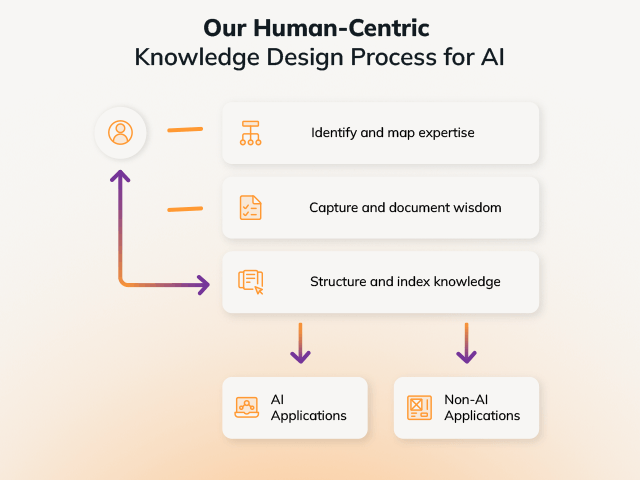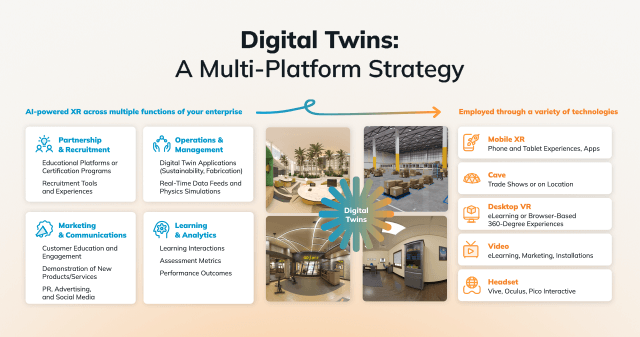Recap: The Current State of AI In Our Organizations
Earlier, we looked in on three types of organizations, each at a different level of AI adoption. In Scenario 1, we described the early adopters, where AI is living, thriving, and actively managed by humans.
What do they have that the others don’t? A strategic AI foundation.
Like anything worth building, AI implementation needs an unshakable base: firm enough to protect its inhabitants, but flexible enough to build upon and reinforce over time.
When we don’t have this, our AI implementation is not only ad hoc; it’s incredibly risky. Scenarios 2 and 3 are riddled with unvetted AI tools and unreviewed, untested outputs of varying quality and accuracy.
AI For L&D: SweetRush’s Human-Centered Strategic Framework
Previously, we shared a brief overview of this pyramid, which we designed to help L&D leaders systematically map their AI ecosystem, amplify human potential, and cultivate ethical, nuanced AI engagement across their organization.

This article focuses on the base of the pyramid, the Strategic Foundation. The Strategic Foundation forms your essential AI groundwork, including a secure data strategy and AI principles, custom knowledge bases for your in-house knowledge and expertise, and AI-VR pairing across functions.
In this article, we’ll focus on three important building blocks (and benefits) of the Strategic Foundation:
- Responsible AI Strategy & Roadmapping
- Enterprise AI & Digital Twin Solutions
- Human-Centric Knowledge Design for AI
Responsible AI Strategy And Roadmapping
Embedding responsibility in your AI strategy from the ground up isn’t just about compliance—it’s a strategic imperative for long-term success.
We also need to consider the human impact of AI: AI is part of a rapidly evolving skill set that will drastically reshape workers’ roles and opportunities in the near future.
“On average, workers can expect that two-fifths (39%) of their existing skill sets will be transformed or become outdated over the 2025–2030 period.”
“If the world’s workforce was made up of 100 people, 59 would need training by 2030.
Of these, employers foresee that 29 could be upskilled in their current roles and 19 could be upskilled and redeployed elsewhere within their organization.
However, 11 would be unlikely to receive the reskilling or upskilling needed,
Leaving their employment prospects increasingly at risk.”
—World Economic Forum Future of Jobs Report 2025
Organizations have an urgent need to develop ethical strategies and roadmaps to manage AI’s human impact. That includes creating guardrails for responsible use and human oversight. These guidelines and guardrails encourage AI adoption: Team members who understand AI and its use are more likely to use it and less likely to fear or mistrust it.
Here’s how the process of roadmapping looks from the ground up.
The Beginning: AI Principles
To build a responsible AI strategy, a focus on values-driven AI principles and needed mental model shifts (MMS) is critical.
How do we land on these? We leverage information from your internal communication channels, values, existing AI guidelines, and much more. We also conduct qualitative analyses and empathy interviews with your people.
We then use our findings about what’s important to your organization to co-create unique AI principles such as “transparency” or “mindfulness of cost.”
Mental Model Shifts For AI
Of course, it’s not enough just to tell people about new tools or policies. To effect real change and foster new behaviors, we must understand and address underlying attitudes, for example, “I’m apprehensive about AI,” or “I have no use for AI tools in my role.”
Therein lies the shift: We then define the vital mindset and behavioral changes your people will need to embrace AI and contribute to a cohesive AI culture in your organization. By aligning the MMS with your unique AI principles, we ensure your teams enact and embody your principles.
(Want to see some case studies of real-life AI principles and mental model shifts? You’ll find them in Chapter 1 of our eBook, The AI Blueprint: Actionable Strategies For L&D Leaders To Reduce Risk, Add Value, And Unlock The Benefits Of AI At Scale.)
AI Meets Humanity: Safeguarding Human Workflows
Turing tests are another step we use in building a responsible AI strategy. Proposed by Alan Turing in 1950, these tests were intended to answer the question, “Can machines think?”
If a human judge couldn’t tell whether they were conversing with a human or a machine, the machine was said to demonstrate human-level intelligence.
At SweetRush, we conduct internal Turing tests to evaluate when and how AI amplifies human potential—and when it doesn’t, or shouldn’t.
Here’s how that works: By reviewing AI outputs, such as language or storytelling, against those of human experts, human judges identify the origin (human or AI), where AI excels, where it needs development, and where human insight is critical.
This process helps us gain clarity on which tasks to automate and identify new opportunities to enhance human expertise.
AI Integrity: Practicing What We Preach
Quality and accuracy of results is the No. 1 concern our client-partners express about AI, and we feel the same.
As L&D professionals, misinformation and bias is anathema to us—and can cause lasting harm to our organizations.
That’s why we’ve committed to an ethical alignment strategy that prioritizes accuracy, transparency, and human validation in all processes—without exception.
We practice what we preach by fact-checking all AI outputs and employing AI detection, using specialized tools to maintain accuracy and support human oversight.
By doing so, we ensure that all AI initiatives are inherently built on trust and ethical principles, which are a priori for a robust strategic foundation.
Human-Centric Knowledge Design For AI
As designers of transformational learning programs, we’re always thinking about how to pair human insight with AI. One way we bring the two together is by creating custom knowledge bases, or meaningful, multi-functional repositories of institutional knowledge and wisdom. These are part of the foundation of your entire AI ecosystem.
Cultivating Institutional Wisdom in the AI Era
With over 400 million terabytes of data generated every day, it’s challenging to filter out what’s relevant, what’s accurate, and how it all fits together. That’s true for us and our learners.
But we can add value by organizing and indexing the following types of information:
- Data are raw facts.
- When organized, data rise to the status of information.
- Institutional knowledge is your organization’s documented facts and processes—all crucial to your efficiency.
- However, institutional wisdom is deeper: It involves the insightful application of institutional knowledge, including ethics, long-term thinking, and nuanced judgment. It’s the source of your people’s creativity and curiosity and helps to catalyze behavior change.
SweetRush’s Human-Centric Knowledge Design Process

Our knowledge design process outlines a holistic, human-centered approach to transform wisdom that lives in the heads of in-house experts into powerful, versatile content. Once captured, this content can fuel AI applications, enrich your websites, enhance your learning programs, and much more.
Here’s what each stage of the process involves:
- Identify and map expertise, or uncover who holds the critical knowledge and insights and where your collective genius truly resides.
- Capture and document the wisdom directly from your experts and learners, focusing on the tacit knowledge, invaluable stories, and nuanced advice that forms your institutional “truth.”
- Finally, structure and index this knowledge using robust frameworks, making it reusable and accessible.
This collection of knowledge then powers two critical pathways:
- Powerful AI applications: For example, AI coaches that provide contextual feedback, or just-in-time knowledge, bringing a high-touch, one-on-one coaching experience to a wider audience and extending the reach of your human experts.
- Non-AI applications, including insights for strategic planning, optimizing operations, and enriching HR initiatives using the knowledge you’ve “downloaded” from your most seasoned and successful in-house experts.
(See examples of institutional wisdom brought to life in our eBook, The AI Blueprint: Actionable Strategies For L&D Leaders To Reduce Risk, Add Value, And Unlock The Benefits Of AI at Scale.)
Enterprise AI And Digital Twin Solutions
Digital twins are dynamic virtual replicas of places, objects, and even people. They’re often built with immersive technologies such as augmented reality (AR), virtual reality (VR), or mixed reality (MR).
Headsets are a great way to visit, but they’re not required: Digital twins can be built with WebXR, a web-based immersive technology that can be accessed via a standard browser window on any device.
AI-powered digital twins can offer profound business insights and help you maximize the value of 3D digital assets across your organization, from internal functions like L&D to external-facing functions like recruitment or customer engagement.
Virtual Worlds, Real Impact: Enterprise AI And Digital Twins
Whether they represent people, places, or things, digital twins are powering new insights and efficiencies across a wide range of industries and sectors.
Benefits of digital twins include:
- Deeper understanding via spatial insights and dynamic feedback
- Increased efficiency
- Enhanced collaboration
- Transformative experiences in learning, marketing, and strategy
The true power of digital twins lies in their multifunctional value. Below are just a few of the ways they can be leveraged to bring different areas of the organization to life for learners, customers, and key stakeholders alike.
Digital twins can be accessed via a range of devices, from trade show “caves,” laptops or tablets, headsets, and even 3D models embedded in videos.

(Check out three real-life case studies of digital twins of people, places, and objects in our eBook, The AI Blueprint: Actionable Strategies For L&D Leaders To Reduce Risk, Add Value, And Unlock The Benefits Of AI at Scale.)
Ready For Next-Level AI?
We hope you’re feeling inspired to break ground on—or expand—your strategic foundation. In our next article, we’ll take you on a tour of the middle level of the pyramid and show you how to translate your foundational AI strategy and roadmap into action.
If you prefer to be your own tour guide, download our eBook, The AI Blueprint: Actionable Strategies For L&D Leaders To Reduce Risk, Add Value, And Unlock The Benefits Of AI At Scale. You’ll find a comprehensive plan to help you build your AI strategy from secure foundation to peak implementation.